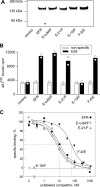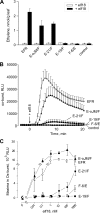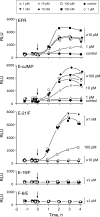Arabidopsis thaliana pattern recognition receptors for bacterial elongation factor Tu and flagellin can be combined to form functional chimeric receptors
- PMID: 20410299
- PMCID: PMC2885181
- DOI: 10.1074/jbc.M110.124800
Arabidopsis thaliana pattern recognition receptors for bacterial elongation factor Tu and flagellin can be combined to form functional chimeric receptors
Abstract
The receptor kinase EFR of Arabidopsis thaliana detects the microbe-associated molecular pattern elf18, a peptide that represents the N terminus of bacterial elongation factor Tu. Here, we tested subdomains of EFR for their importance in receptor function. Transient expression of tagged versions of EFR and EFR lacking its cytoplasmic domain in leaves of Nicotiana benthamiana resulted in functional binding sites for elf18. No binding of ligand was found with the ectodomain lacking the transmembrane domain or with EFR lacking the first 5 of its 21 leucine-rich repeats (LRRs). EFR is structurally related to the receptor kinase flagellin-sensing 2 (FLS2) that detects bacterial flagellin. Chimeric receptors with subdomains of FLS2 substituting for corresponding parts of EFR were tested for functionality in ligand binding and receptor activation assays. Substituting the transmembrane domain and the cytoplasmic domain resulted in a fully functional receptor for elf18. Replacing also the outer juxtamembrane domain with that of FLS2 led to a receptor with full affinity for elf18 but with a lower efficiency in response activation. Extending the substitution to encompass also the last two of the LRRs abolished binding and receptor activation. Substitution of the N terminus by the first six LRRs from FLS2 reduced binding affinity and strongly affected receptor activation. In summary, chimeric receptors allow mapping of subdomains relevant for ligand binding and receptor activation. The results also show that modular assembly of chimeras from different receptors can be used to form functional receptors.
Figures





References
Publication types
MeSH terms
Substances
LinkOut - more resources
Full Text Sources
Other Literature Sources
Molecular Biology Databases

